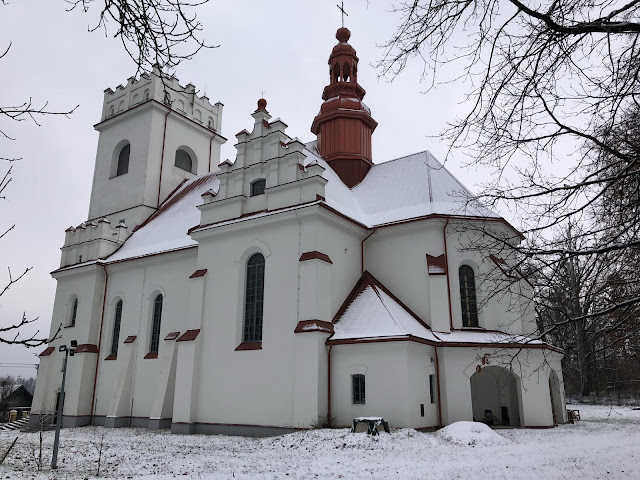There is something special about the Polish-Belarusian border and the whole area here. This is a place where many cultures, different peoples, and religions have mixed throughout its long history, but this blog will focus more on nature and the bison here. Believe it or not, it is possible to see bison on the road. I was lucky enough to spot them just 100 meters away, standing in herds, many of them together and completely still. During my visit to Białowieża, there was also snow, which made the experience truly magical.
 |
| Bison walking in the snow |
How to Get to Białowieża
There are a few options to get to Białowieża, and the easiest one is by car. It's pretty simple to find parking, and the roads are very well marked, so you can get there even without navigation. Public transportation is a bit trickier. I took a bus from Hajnówka, which I reached by train from Warsaw. The bus ticket was 13 zł, and I paid directly to the driver. The bus station in Hajnówka for Białowieża is located next to the Catholic church on 3 Maja Street. There is a bus schedule at the stop, but this can be tricky because our bus was not on time, and the sign on the bus didn’t even say "Białowieża." I will upload the bus schedule above. Also, be careful because there are fewer buses running on weekends. The ride is about 25 km and takes roughly 40 minutes. The road itself is magical, cutting through the middle of the forest where you can also see many dead trees next to the road. One local man complained about this, saying it makes no sense to leave them there, but due to laws, it’s forbidden to remove them.
 |
| Wooden bisons |
What to See in Białowieża
Białowieża Forest is one of the oldest and largest forests in Europe. That fact alone was enough to draw me to this place. This forest has shaped this part of Europe in many ways throughout history, including witnessing some brutal events.
 |
| Chatolic church |
Near the last bus stop, there is a Catholic church that looked like a castle to me. Built in 1739, it holds many stories about Catholics living here, later converting to the Orthodox faith, and then back again. Next to the church, you’ll find the Historical Directorate Park. This park is fascinating as it tells the story of the forest and the control over it throughout history, always shifting between Russians, Poles, Lithuanians, and Germans. It also highlights the area’s rich natural resources and their value.
 |
| Ortodox Church |
This place became known to Polish kings at the end of the 16th century, marking it as a "royal site." Some parts of the forest were cleared to make room for a new village, which was named Białowieża. In 1795, the area came under the control of the Russian Empire, where it remained for over 100 years. There is also a monument dedicated to Józef Piłsudski, the Polish marshal. Białowieża is now the center of forest education in Poland and across this part of Europe. During the two world wars, control of the forest alternated between Russians, Germans, and Poles. Finally, in 1945, it became the border between the USSR and Poland, and today it is the border between Poland and Belarus. The border control point is about 4 km down the road from the village.
 |
| Enterance to the Rezerwat |
The average age of the standing trees here is 98 years, with some pines as old as 400 years. Walking and hiking are very popular in the area, and you can see incredible natural species, including bison, wolves, and moose. There are also many endemic birds, such as the Collared Flycatcher and Red-breasted Flycatcher.
The Palace Park
This magical park has attracted visitors throughout history, including Russian tsars. They built a mansion here between 1898 and 1894 on the site of older buildings once used by Lithuanian and Polish kings. In this park, you can stroll next to two lakes and visit attractions such as the museum, palace gate, bathhouse, mill, or obelisk.
 |
| Palace Park |
Bison Reserve
To reach the reserve, you need to walk about 6 kilometers from Białowieża. Along the way, I noticed several places to eat and stay. The entrance ticket costs 20 zł, with discounts for students. Besides bison, you can also see lynxes, wolves, moose, and horses here. The reserve offers a pleasant walking area, and you can easily spend two hours without getting bored. Just don’t touch the goat fence—it’s electrified (don’t ask how I know!). The surrounding area is called Rezerwat Krajobrazowy im. Władysława Szafera.
Conclusion
Białowieża is definitely worth a visit, even if just for one day. If you’re traveling by car, you’ll have more time to relax and explore the hiking trails and other sites. If you’re using the bus, be careful about the return trip to Hajnówka since public transportation options are limited. The bus stops are well marked, so they’re easy to find.
Białowieża is located in the Polish region of Podlasie, which stands out for its unique charm and character, setting it apart from the rest of Poland. The bison is the symbol of this area, appearing everywhere—from regional logos to beer, vodka, restaurants, cafes, and more.
 |
| Frozen Lake |
It’s possible to see bison outside the reserve too. I was lucky to spot them twice more on the road—once near the village of Nowosady and another time on the way from Hajnówka. The first time, I saw a large group, but the second time there were just two, likely a couple. The forest has a noticeable police presence due to the EU and NATO border. If you’re planning to come here, do it. It’s worth it.
 |
| Beatiful House |